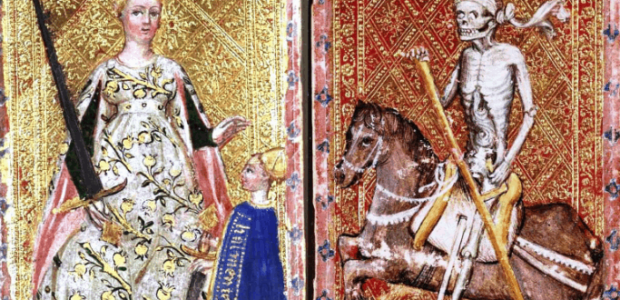Unearthing the Gothic is a monthly column where we explore the vast and exciting world of gothic horror media as a way to exhume it from the margins of conversation and preserve its importance to the genre.
Angela Carter’s dreamy gothic fairytales have endured as important feminist literary texts. Carter often brought the horror elements found in fairytales to the forefront, creating tales that honored their terrifying roots and also plumbed the depths of womanhood at the same time. To say Carter was a complex storyteller would be an understatement. Perhaps one of her most famous stories and the one that most readers think of when one mentions gothic and Angela Carter is the retelling of Little Red Riding Hood titled “The Company of Wolves,” a formidable short story in its own right from the iconic collection The Bloody Chamber. However, “The Lady of the House of Love” featured in the same collection is just as brilliant with its lush vampiric riff on Beauty and the Beast.
For the sake of background, “The Lady of the House of Love” started life as a radio play titled Vampirella before being reworked into the short story being examined today. The two have their differences but hinge on the central character known as the Countess. The Countess is presented as self-loathing and struggling to come to terms with her vampirism in both the source radio play and the short story. She comes from a long line of famous and noble vampires, and in the radio play, she is the daughter of Dracula. The short story posits her as the last of her kind, a relic from a bygone era left moldering in a desolate and decaying castle. She is both the princess to be rescued and the monster. It’s a fairytale by the way of generational trauma, desire, and longing. Of course, it’s all imbued with the murky and morbid sexuality that all gothic fare is.
Carter flips the script. It’s often the monstrous man and the virginal maid but not here. The Countess is the monster, tainted by the circumstances of her birth. She’s descended from Vlad the Impaler after all. There is little choice and little chance for another sort of life. The prose is burdened with her own existential pain. Her days are spent in the castle with her old governess, her tarot cards, and her birds. She constantly amuses herself with the tarot deck, trying to divine a future that seems to be rife with heartache and bloodlust. The Countess wants to indulge in her humanity. She longs to keep rabbits as pets without desiring their blood. Then, there are the young men that she drains. The governess can bury their bodies, but the Countess cannot bury the guilt that looms over her. It’s a pitiful existence, one filled with unbridled want and desire and with little release. She feels haunted by her ancestors and the lives they’ve lived and the lives they’ve taken. Her fate isn’t her own. She’s damned.
The Countess gets a shock one evening when she’s reading her cards. She draws the love card, one she has never drawn before. Love does come but in the form of a virginal young man who is passing through the village on bicycle. The young man is invited in by the governess under the guise of lodgings and a meal. After eating, he meets the Countess. The two are naturally captivated with one another. She’s a gorgeous vampire who is all death and intrigue, and he’s a strapping young man who has a sort of enduring and endearing purity. They seem diametrically opposed, but in the world of Angela Carter, they are united by passion.
Suffice to say, the story is embedded with white-hot sexuality where the draining of blood is associated with intercourse. Swapping juices gets a whole different meaning when vampires are involved, but it’s no less erotic. One striking moment in the story sees the Countess cut her finger on glass. Her finger is naturally bleeding, and the young man comes and kisses the injured finger. It’s another subtle subversion, the vampiric act made to be one that is tender and raw, and of course, indicative of sex. While there is no explicit sex acts in this short story, everything is drenched in sex. The Countess is a symbol of sexual repression and just general human desire and the arrival of the young man signifies the freedom she so desperately craves. It is through him she can break the curse of her birth and the hold that her familial burden has on her.
For the sake of the reading experience, this piece won’t spoil the story further because it is truly worthy of a read. The prose is gorgeous and is filled with the ache of want. The story itself is like a neatly contained and ornate haunted house, dotted with beautiful words and heady emotion instead of bats and cobwebs. If one is partial to reading gothic horror, this is truly a decadent slice of the subgenre that has likely escaped many people’s radars. It has all the trapping of vampire romances as well yet is a bit more thematically substantial than say Twilight or True Blood. Not to knock Twilight or True Blood, but Carter’s take on vampiric romance is ethereally complex. Regardless, there should be more conversation generated around one of Carter’s more underrated tales. While there are no wolves to keep one company in this one, there is a vampiric countess, and for many that will be just as satisfying.
Interested in listening to the radio play this short story is based on? You can listen here.
If you’ve not read the story, you can purchase a copy of The Bloody Chamber here.
Tags: Angela Carter, beauty and the beast, Books, Gothic Horror, Short Stories, The Lady of the House of Love, Unearthing the Gothic


No Comments